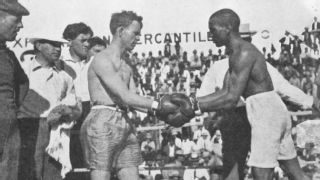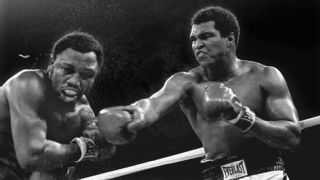|
After two or three rounds, everybody inside the Mohegan Sun Arena on the evening of May 18, 2002, knew something extraordinary was taking place. This was more than just another good fight. The crowd was going nuts and members of the ringside media were leaning forward in their seats, craning their necks to get a closer look at what was taking place before their eyes -- the normal kibitzing and wisecracks forgotten as they were carried away by the spectacle. After the postfight news conference, hard-bitten boxing writers drifted back to ringside as if in a trance, reluctant to leave the scene that had given them a glimpse into the souls of the combatants and the heart of boxing. It was, of course, the first Mickey Ward-Arturo Gatti fight, an incredible war that turned into a trilogy. Ward won the decision that night, and Gatti got the nod in the second and third fights. All three were terrific, and by the time they were done, Gatti and Ward were linked forever, two men who had sacrificed their bodies on the altar of their art.  The first Gennady Golovkin-Canelo Alvarez match wasn't anywhere near as good as any of the Gatti-Ward fights, but it was close, ended in a controversial split draw and was a massive moneymaker. The rematch, won by Alvarez, was an all-action battle, especially in the later rounds, but is the rivalry between Canelo and GGG worthy of a third fight based on what took place on Saturday? As we know from past examples, there are numerous scenarios that can result in a boxing trilogy. Personal animosity and contentious outcomes led to prizefighting's first well-know trilogy, between William "Bendigo" Thompson and "Big" Ben Caunt for the English bareknuckle championship. A lack of sportsmanship and a bevy of underhanded tactics were the order of the day when this pair came to scratch. Their first battle, in July 1835, ended in a disqualification when Caunt, enraged by Bendigo's evasive maneuvers and taunts, walked to his opponent's corner between rounds and hit him with a cheap shot while he was sitting on his second's knee. The rematch, in April 1838, also ended in disqualification when Bendigo allegedly went down without being hit. Thompson instigated a third match by belting Caunt on the jaw in a pub. The rubber match took place in September 1845, and after 2 hours, 10 minutes of fighting Bendigo was declared the winner on a foul, when Caunt sat down without being hit. That's when the riot began. While neither Alvarez nor Golovkin struck the other while he was seated on his stool between round, the ill will fostered by Canelo's failed PED test, which led to the cancellation of the original May 5 rematch date, definitely irritated the usually unflappable "GGG." "I told you, it's not Mexican meat," Golovkin said. "This is Canelo. This is his team. This is his promotion. Canelo is cheating. They're using these drugs, and everybody is just trying to pretend it's not happening." There are, of course, plenty of ways to cheat. One of the most famous of the early gloved-era trilogies was between lightweights Joe Gans and Battling Nelson. Again, it was a foul that launched the trilogy.  The end of their first fight, in September 1906, came in the 42nd round when Nelson, who was being out-boxed, drove a right hand into Gan's groin. The low blow was so flagrant referee George Silver had no alternative but to disqualify Nelson. Nelson won by knockout in the second and third bouts. Gans was in the late stages of tuberculosis and shouldn't have been in the ring, but he needed the money. Two years later, "The Old Master" died of the disease. Boxing upsets are a glimmer of light in what author Donald McRae called the "Dark Trade," a sport in which the odds are always stacked against the underdog. They are also often impetus for a trilogy, especially if the loser is a rising star. Roberto Duran had been lightweight championship for about five months when he returned to Madison Square Garden, site of his title-winning fight with Ken Buchanan, in November 1972. It was a non-title catch weight bout, a showcase for the strutting destroyer from Panama. In the other corner was Esteban De Jesus, a sleek young Puerto Rican of considerable skill, who would eventually prove to be Duran's most challenging lightweight adversary. DeJesus knocked down Duran with a left hook in the first round and went on to win a unanimous decision. Not even Duran could say he was robbed. The rematch with the title on the line in March 1974 started out in similar fashion when DeJesus again decked Duran in the opening round. This time, however, "Mano de Pierdra" fought his way back into the fight and knocked out DeJesus in the 11th round. These guys were meant for each other.  A third fight, in January 1978, became viable after DeJesus won a lightweight title and made two successful defenses. Duran knocked him out in the 12th round, ending the bitter rivalry once and for all. It's counterintuitive, but some of the most celebrated trilogies include a fight that wasn't anywhere near as good as the other two. For decades the Tony Zale-Rocky Graziano middleweight championship series, which took place in 1946, '47 and '48, was widely considered the greatest trilogy of all time. "They weren't fights, they were wars without survivors," wrote historian Bert Sugar. And it's true. The first two bouts were mind-blowing shootouts, with Zale rallying from behind to knock out Graziano in the 11th, and Graziano doing likewise to stop Zale in the sixth. Unbelievable stuff. The third fight, however, was a rout. Zale knocked down Graziano three times in less than three rounds. It was all over at 1:08 of the third. Had their first bout been as uncompetitive as the third there never would not have been a trilogy. The first thing most fans think of when trilogies are mentioned is the Muhammad Ali-Joe Frazier rivalry, and it's easy to understand why. Fame, contrasting personalities, the sociopolitical ramification of the time, plus the fact both were undefeated heavyweight champions made it irresistible.  The first and the last -- "The Fight" and the "Thrilla in Manila" -- are twin peaks of arguably the greatest heavyweight era of all time. Nonetheless, their second fight, in January 1974, was a comparative dud, thanks in part to referee Tony Perez. He stepped between the fighters near the end of the second round, moments after Frazier was hurt by a right hand, giving him extra time to recover. Perez said he thought he heard the bell, which is certainly possible. But allowing Ali to push down on Frazier's neck (a foul) repeatedly throughout the match was inexcusable. Ali won the decision in a fight that is pretty much forgotten, sandwiched, as it was, between two iconic struggles. Some of the finest trilogies have been between boxers in the lighter weight classes, classics such as Ruben Olivares vs. Chucho Castillo (bantamweight), Daniel Zaragoza vs. Paul Banke (junior featherweight) and Bobby Chacon vs. Olivares (featherweight, junior lightweight). Then there's Marco Antonio Barrera vs. Erik Morales, a trilogy fought in three different divisions -- junior featherweight, featherweight and junior lightweight. The first Morales-Barrera confrontation, in February 2000, was surreal. They tore into each other with such relentless ferocity it was almost impossible to believe your eyes. They traded flurry after flurry for 12 of the most exciting round ever witnessed, with Morales winning a split decision. If you've never seen it, head straight to YouTube. You won't be sorry. Barrera won a unanimous decision in the second match in June 2002, and a majority decision in 2004. They were almost as good as the first. Barrera and Morales genuinely hated each other back then and fought like it. But when Morales was inducted into the International Boxing Hall of Fame in June 2018, he and Barrera, who had been enshrined in 2017, greeted each other with great warmth and respect. That's what usually happens when two boxers realize they had created something remarkable together. Based on what we saw last Saturday, was Golovkin-Alvarez II good enough to do it one more time?
|
